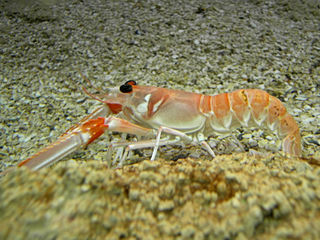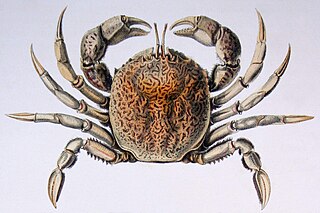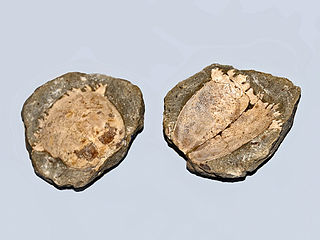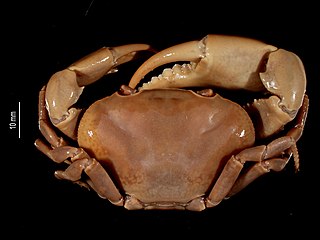
Xanthidae is a family of crabs known as gorilla crabs, mud crabs, pebble crabs or rubble crabs. Xanthid crabs are often brightly coloured and are highly poisonous, containing toxins which are not destroyed by cooking and for which no antidote is known. The toxins are similar to the tetrodotoxin and saxitoxin produced by puffer fish, and may be produced by bacteria in the genus Vibrio living in symbiosis with the crabs, mostly V. alginolyticus and V. parahaemolyticus.

Nephrops is a genus of lobsters comprising a single extant species, Nephrops norvegicus, and several fossil species. It was erected by William Elford Leach in 1814, to accommodate N. norvegicus alone, which had previously been placed in genera such as Cancer, Astacus or Homarus. Nephrops means "kidney eye" and refers to the shape of the animal's compound eye.

Palicus is a genus of stilt crabs in the family Palicidae.

Belliidae is a family of crabs of the order Decapoda.

Palaemon is a genus of caridean shrimp in the family Palaemonidae.

Potamonautes is a genus of African freshwater crabs in the family Potamonautidae. It is both the most widespread and most diverse genus of African freshwater crabs, including more than half the species of this continent. They are found in most freshwater habitats of the African mainland and some species are semi-terrestrial.

Ovalipes australiensis is a species of crab found in southern Australia. Its range extends from Western Australia to Queensland, including Tasmania. It is fished commercially and recreationally, although it is not as important as the blue swimmer or mud crab.

Ranina is a genus of crabs belonging to the family Raninidae.

Panopeus is a genus of crabs, containing these extant species:

Pseudothelphusa is a genus of crabs in the family Pseudothelphusidae, containing the following species:
Hypolobocera is a genus of crabs in the family Pseudothelphusidae, found only in the San Juan River basin which drains into the Pacific, in Colombia. The major and future threats to this species include human-induced habitat loss/degradation and water pollution.

Neopseudothelphusa is a genus of crabs in the family Pseudothelphusidae, containing the following species:

Hepatus is a genus of crabs in the family Aethridae, containing seven extant species, plus some fossil species:
Osachila is a genus of crabs in the family Aethridae, containing three fossil species, and the following extant species:

Actaea is a genus of crabs in the family Xanthidae, containing the following species:

The Panopeidae are a family containing 26 genera of morphologically similar crabs, often known as "mud crabs". Their centers of diversity are the Atlantic Ocean and eastern Pacific Ocean.

Ebalia is a genus of crab in the family Leucosiidae.

Microphrys is a genus of crab in the family Majidae, containing the following species:.
Randallia is a genus of true crabs in the family Leucosiidae. There are about 17 described species in Randallia.

Leptuca is a genus of fiddler crabs belonging to the family Ocypodidae.
















